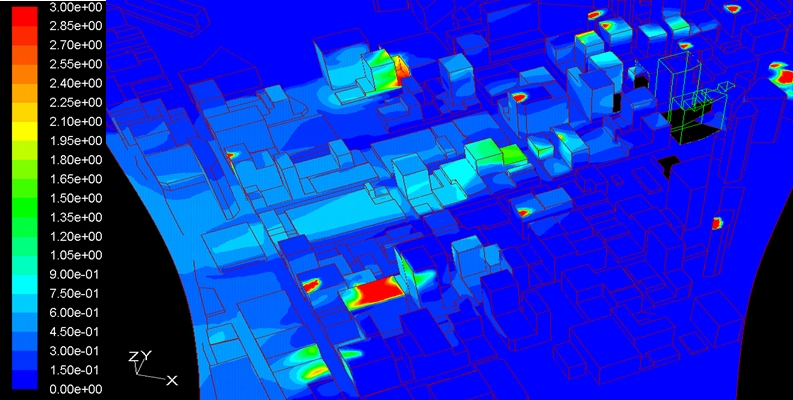
engineering & technology publications
ISSN 1759-3433
PROCEEDINGS OF THE FIFTH INTERNATIONAL CONFERENCE ON ENGINEERING COMPUTATIONAL TECHNOLOGY
Computational Fluid Dynamics Simulations of Plume Dispersions in City Canyons
Vipac Engineers & Scientists, Lane Cove NSW, Australia
- Develop a model of the entire city;
- Incorporate the generators into the model;
- Predict pollutants concentrations namely NOx on the city ground level;
- Predict pollutant concentrations buildings walls and balconies for a number of prevailing winds directions;
- Study the impact of stack heights on the city air quality and building air conditioning intakes; and
- Optimise number and locations of the proposed generators.
In general two methods are available to achieve the above objectives: wind tunnel test and computational fluid dynamics (CFD) simulations. A comparative study has ruled out the use of wind tunnel tests for this task due to the scale and stack detail issues. The CFD model incorporated the following:
- A computational domain of about 23.6 km2 floor area.
- Thirty exhaust stacks with a typical stack diameter of 0.250 m.
- Accurate terrain effect of the inner city buildings.
- Building features of less than 1 m for areas of interest.
- Detailed building gap configurations in the region of interest.
Three dimensional incompressible steady flow computations were carried out
using the commercially available code Fluent. This solves discretized forms of the
Reynolds average Navier Stokes (RNAS) equations for turbulent flow using the
finite volume methods. The flow characteristics are seen to be captured well by the
two equations turbulence
![]() model. Details of
model. Details of
![]() can be seen in [1]. The solution
is combined with a wall function to avoid using fine elements near the walls of the
buildings. A solution adaptation technique was finally employed to refine the cells
based on initial results. For example refining the cells in the locations where
higher-pressure gradients are obtained. The number of cells after the adaptation technique
was used for most of the cases was in the order of 4,000,000 unstructured cells. The
analysis was executed on a Linex platform using a new series of four Opteron
processors with 8Gb RAM.
can be seen in [1]. The solution
is combined with a wall function to avoid using fine elements near the walls of the
buildings. A solution adaptation technique was finally employed to refine the cells
based on initial results. For example refining the cells in the locations where
higher-pressure gradients are obtained. The number of cells after the adaptation technique
was used for most of the cases was in the order of 4,000,000 unstructured cells. The
analysis was executed on a Linex platform using a new series of four Opteron
processors with 8Gb RAM.
The CFD analysis offered a comprehensive range of output including pollutant concentrations, velocity distribution, pressure profile, turbulence levels, etc. and allowing the identification of the generators that have unacceptable impact on the city air quality. It is anticipated that the use of CFD for entire city modelling will be a useful tool to help urban designers and environmental planners.
- 1
- B. Launder and D. Spalding "The Numerical Computation of Turbulent Flows", Computer Methods in Applied Mechanics and Engineering, 3(3), 269-289, 1974. doi:10.1016/0045-7825(74)90029-2
purchase the full-text of this paper (price £20)
go to the previous paper
go to the next paper
return to the table of contents
return to the book description
purchase this book (price £105 +P&P)
